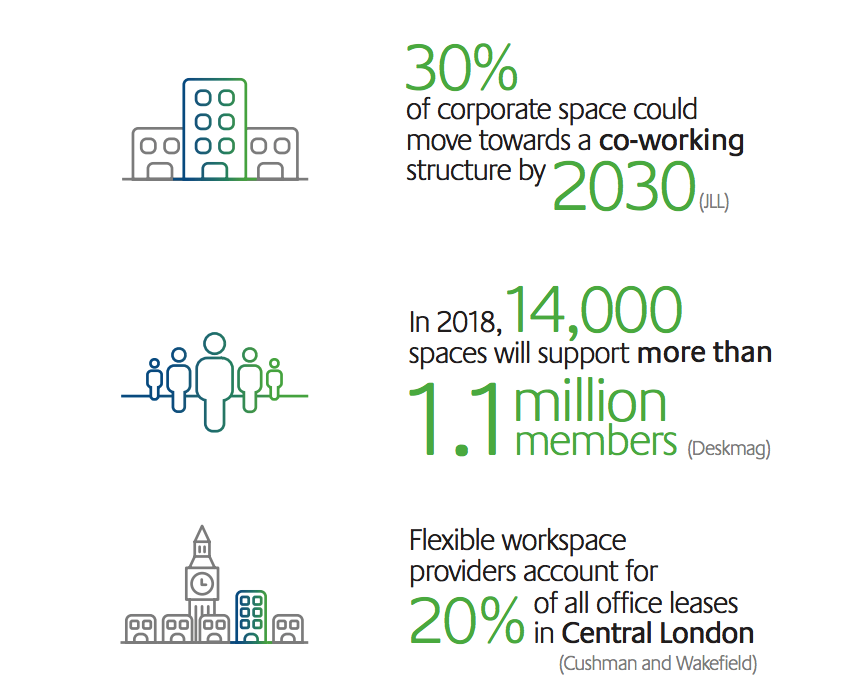What the rise of co-working means for commercial property
Over the past decade, the use of space in office buildings took a collaborative turn, with activity-based working helping corporates decrease their space requirements by up to 20%. Now, co-working is the latest and rapidly growing workplace trend that will change the way we work – and invest. Head of Global Property Securities, Stephen Hayes, breaks down the demand for co-working space, the potential pitfalls and what this all means for building owners.

There has been exponential growth in the co-working market; affordable short-term space targeting free agents, contractors and start-ups.
Fast-growing WeWork allows its 175,000 to book into any WeWork office space globally and has an average occupancy of 88% across its tenancies.
Cushman and Wakefield report that WeWork is now central London’s biggest office occupier, with flexible workspace provider’s accounting for 20% of all office leases across the city. Co-working spaces increased by 30% in 2016 – and by the end of 2018, as many as 14,000 spaces will support more than 1.1 million members, according to Deskmag. JLL predicts that 30% of corporate space could be under flexible leasing terms primarily within a co-working structure by 2030.
There are two drivers of demand:
Independents
Individuals or groups that previously operated out of casual workspaces such as cafes or industrial spaces that are now at the stage that a communal work environment has appeal. Any degree of capture of this segment of potential office space users would be an incremental positive for office landlords. Based on US data a shift from 2% to 5% market penetration of the independent pool of space users could result in a ~2% incremental increase in net office space absorption.
Enterprises
‘Enterprise’ or users drawn from the corporate segment offer leases with superior credit quality to those of the independents. They are (potentially) a stickier source of revenue in the event of an economic downturn given enterprise contracts/leases range from 6 months to 5 years (usually 1-3 years) when compared to month-to-month terms for the typical independent worker. Enterprise clients now represent 20% of WeWork’s members and 30% of its revenue. This element of demand is expected to grow given recent leasing deals secured by WeWork such as a new 450,000 (sqf) building in Silicon Valley in which WeWork expects to be filled with enterprise customers of which 50% is reportedly linked to Amazon – a repeat customer of WeWork.
Office market impacts
Co-working is unlikely to convert all enterprise users, but it’s still growing fast – While enterprise users of co-working space are unlikely to diverge en masse from their existing accommodation models, the impact from ‘enterprise’ growth could be a net negative with corporate users potentially reducing their overall office footprint.
The issue then becomes one of a trade-off depending whether or not enterprise space optimisation exceeds the benefits of aggregation among the independents sector. US gateway markets have been the early adopters of co-working businesses, led by New York City where WeWork alone leases 3m (sqf). WeWork has 40 leasehold locations in NYC which increases to 55 if we include Brooklyn. WeWork expects to increase its global locations by 31% in the short-term.
Heavy co-working occupancy can cause building values to fall - WeWork will typically enter into 15-year leases, offering tenor appeal to a landlord. However, the quality of the lease covenant is still up for debate.
WeWork leases typically don’t offer a parent guarantee for the entire lease tenor and while evidence is limited from the data available, we estimate that when WeWork occupies between 50%-100% of a building its value will typically be lower, with a capitalisation rate premium placed on the valuation of 50-75 basis points.
While housing a co-working business within an office building may have appeal for some corporates, any material occupancy by a co-working sponsor such as WeWork could see building systems worked harder as a result of 24/7 usage and higher occupancy ratios than if occupied by a typical corporate tenant. Furthermore the amenity for corporate tenants can be negatively affected if lift rises are shared between corporate office users and clients/users of co-working facilities.
Co-working businesses may fare poorly under a recessionary environment – Co-working businesses have large committed operating lease liabilities and shorter duration revenue streams where co-worker memberships can easily be rescinded. For example, Regus the largest co-working business now operating under its “Spaces” brand had its US business file for Chapter 11 (bankruptcy) during the last recession.
For further information on our Global Property Securities products, please click here.
3 topics

